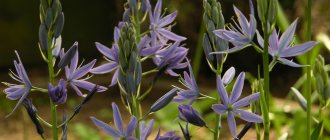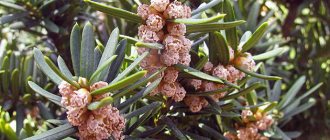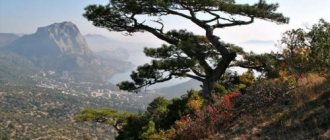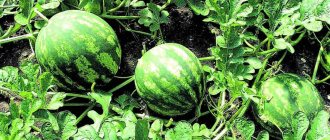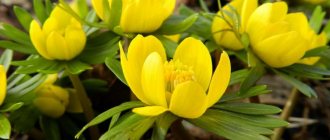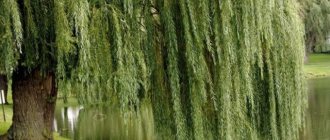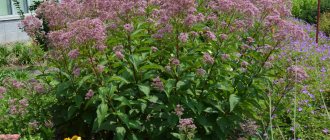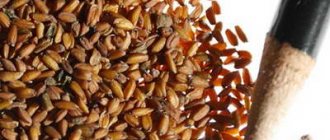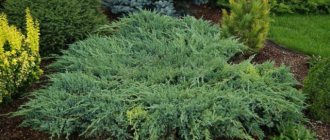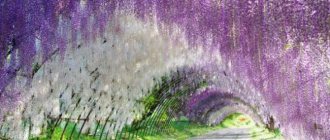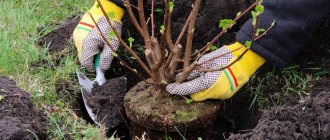In winter, trees are dormant and do not require special care, but after the snow melts they require increased attention. Proper care of coniferous trees in the spring will help maintain the decorative appearance and health of the plants. In addition, coniferous plants are considered unpretentious, but certain care measures will still be required.
From the article you will learn how to plant conifers correctly, trim them to form a decorative crown, and which varieties are best to choose for decorating your garden plot.
- Why is pruning needed?
Planting coniferous trees on the site
It is better to plant such crops on the site in spring in accordance with the advice of a specialist. This will help maintain the viability of the seedlings and speed up their acclimatization in a new location.
Note: Plants can be replanted as adults, but it is better to use young seedlings. They take root much faster, and planting a small tree or bush is much easier than planting a large crop.
To properly plant a coniferous crop, you need to do the following (Figure 1):
- Planting material in containers can be transplanted into open ground all year round. Saplings with an open root system are planted only in early spring or mid-autumn. It is important to preserve the earthen ball in which the root system is located.
- The location is chosen in accordance with the characteristics of the variety. Most of these plants tolerate shade well, but in areas with too much light they can get sunburned. However, there are varieties that are very sensitive to light and should be planted in open spaces with good natural light.
- The area should not be swampy. In other words, they choose a place with a low groundwater level, but if this is not possible, they arrange drainage.
- The size of the planting hole is determined individually. The hole should be such that the root system of the seedling can fit freely into it. A mixture of deciduous soil, peat and sand is laid on the bottom.
Figure 1. Features of planting conifers
After planting, the seedling is watered abundantly so that the soil adheres more closely to the roots and the crop takes root faster in the new place.
Peculiarities
Among the features of planting is the correct placement of the seedling in the hole. The hole should be deep enough so that the root collar of the plant is above the ground level.
How to care for coniferous plants
Coniferous plants rightfully have a special place in landscape design, because in the off-season and winter only they enliven the garden with fresh, bright colors. Evergreen fragrant conifers are the undisputed “soloists” of the garden due to their beautiful texture and rich palette of needles, the color of which varies from dark emerald, bluish-green and silver-gray to bright golden. The undeniable advantages of coniferous plants, matching their beauty, is resistance to adverse weather and environmental conditions. Pines, spruces, cypress trees, yews, thujas, junipers and other representatives of the numerous evergreen tribe have long “settled” next to people, being their favorites. After all, they are not only decorative all year round, but have phytoncidal properties, purify the air, and have a beneficial effect on the human body, giving it health. The prevailing opinion about the absolute unpretentiousness of conifers to the conditions of care and the environment, to put it mildly, does not entirely correspond to reality. In order for coniferous plants to feel comfortable, you need to adhere to certain rules regarding their location, watering, fertilizing, pruning and wintering.
When deciding to plant conifers on a site, you must take into account the fact that conifers are known sun lovers, especially when it comes to:
- larches;
- pine trees;
- oil;
- fir and juniper.
They can grow in light partial shade, but it is undesirable to place plants in areas of the garden completely deprived of sunlight. Yew, hemlock and cypress trees are less demanding on light.
Conditions for proper care include regular weed control and careful weeding: weeds must be removed promptly and conscientiously, as they are catalysts for the development of diseases, attract pests, block light for plants and take away nutrients and fertilizers. Weed control chemicals should be used very carefully and only when absolutely necessary. Therefore, it is better to prevent the appearance of lush thickets of weeds near the plants. Weeding of the root zone and the area adjacent to the conifers is best done after watering before mulching.
During the first time after planting, coniferous plants are very sensitive to lack of moisture, so they need to be watered regularly. If it's hot outside and your coniferous plant grows in a sunny place, you need to shade it. It is advisable to tie it to a pole, which will keep the plant from gusts of wind (until the plant takes root in a new place and its root system is strengthened).
The second, no less important requirement of conifers is the choice of soil. Almost everyone prefers loose, fairly moist soils with a slightly acidic environment. Please note that coniferous plants do not like high organic content in the soil; moreover, it can be destructive for them. Optimal soil composition: light sandy loam or loam with the obligatory addition of turf soil, peat and sand when planting in a ratio of 2*1*1. Pine, spruce and juniper trees are less demanding on soil moisture.
You should not ignore such care conditions as fertilizing. Fertilizer is applied in spring and until mid-summer. The optimal type of fertilizer is compoa -height: 1.5;»> (3 5 kg per 1 sq.m); Vermicompost is a good option (you can buy it in specialized stores).
Note! Coniferous plants, by and large, do not particularly need fertilizing and fertilizers (except for the first 2 - 3 years), so “it is better to underfeed than to overfeed,” since excess fertilizer can lead to the death of the plant. Under no circumstances should you apply nitrogen fertilizers!
The issue of preparing conifers for winter and wintering itself deserves special attention. Coniferous plants are mostly frost-resistant (up to -40 degrees) and winter well, but almost all seedlings in the first 3 years of life need winter shelter, which is removed after the snow has completely melted. The worst enemies of conifers in winter are not only frosts and snow piles, but also the bright active sun (until early spring) with a cruel drying wind. The needles do not freeze, but dry out and “burn.” This is also facilitated by freezing of the soil, which does not allow the necessary life-giving moisture to reach the roots. Therefore, let us remind you that it is so vitally important to water the conifers abundantly before “hibernation”. No less dangerous for coniferous plants in winter is such a natural phenomenon as “ice rain”: the branches become covered with a crust of ice and break under its weight until the tree dies.
Thuja, yew, cypress, juniper, Canadian spruce, elite dwarf varieties and bonsai are especially sensitive to the problem of needles burning out. A problem for decorative varieties can be the complete loss of the decorative shape of the crown. Shelter is necessary, and the best option is to wrap it in white spunbond or light burlap. Under no circumstances should you use film: the plant under it will “suffocate” and may die. Frost-resistant adult coniferous plants do not require special shelter, unless you can attach spruce branches to the branches in tiers (from bottom to top).
Another dangerous enemy of conifers in winter, in addition to freezing of the roots and burning of the needles, is a fungus that infects the plant in warm and humid snowy winters. A sign of the disease is darkening of the needles. In this case, diseased branches should be immediately removed and burned, and the plant should be treated with fungicides. The best preventive measure against the appearance of fungus is regular monitoring of covered plants, freeing them from snow “captivity” (drifts) to avoid damping off.
Wintering is a difficult period in the life of every plant and conifers, but with proper care, adhering to the necessary requirements, pines, spruce, thuja and other conifers will winter well, maintaining health and beauty.
In the spring, mandatory sanitary treatment of coniferous plants is carried out: frozen, diseased, dry and injured branches are removed, the crown of mature trees is thinned out (once a year). Light pruning in the spring is beneficial for all coniferous plants - their crown becomes thicker and branches abundantly. Formative pruning of ornamental varieties is carried out in the spring before the start of sap flow (late February - March). Particular attention should be paid to shaped cutting of decorative forms (topiary, bonsai): it should be carried out during the growth period of shoots in June - July, combined with pinching fast-growing shoots or removing buds that are undesirable for the formation of a spherical or figured crown. Remember that after any haircut or pruning, the coniferous plant must be fed and watered abundantly to restore the disturbed vital and water balance.
These are, in brief, the basic tips for proper care of coniferous plants. We hope that our tips will help you grow beautiful trees and shrubs that will give you joy all year round.
Pruning coniferous trees in spring
Caring for coniferous plants in the garden includes moderate pruning and crown formation. In early spring, all seedlings are inspected and damaged or frozen branches are removed.
It is not recommended to cut branches heavily. These crops grow slowly and may not have time to grow a large green mass by winter. A sparse crown makes the tree more vulnerable to frost and wind.
Why is pruning needed?
The main purpose of pruning in the spring or throughout the year is to remove dead or damaged branches. Since most varieties grow slowly, branches need to be trimmed minimally and very carefully.
Figure 4. Trimming rules
Moderate pruning stimulates branch growth and makes the tree or shrub appear fuller. The crown of adult plants can be given a certain shape, but for this you need to use a special frame or stencil so as not to remove excess branches (Figure 4).
Peculiarities
Pruning, as a stage of plant care in the spring, has some features. Firstly, all manipulations must be carried out only with a clean and sharp instrument. The cut must be smooth and free of infection. If the hacksaw or pruning shears are dirty and pathogens enter the wound, the tree may die. For this purpose, the sections are additionally treated with potassium permanganate or garden varnish.
Needle cleaning and sanitary pruning
The dying off of needles is a natural process. Every 2-4 years the tree sheds old, outdated needles. The largest number of them are located inside the crown.
If coniferous trees are not cleaned, then after a couple of seasons the plant will be clogged with yellowed needles. This will not only worsen his appearance, but will harm his health. Obsolete needles block the sun and interfere with normal air exchange. In addition, rotted needles become a breeding ground for diseases and a shelter for pests.
In the fall, it is impossible to properly clean the tree, since the wilting process continues until December. It is better to clean and trim pine or thuja in the spring, when the temperature reaches above zero.
To do this you will need thick gloves and pruning shears. Old dry branches are cut close to the trunk. New shoots will emerge from the buds established in these places. Living pine branches are cleaned by picking off the yellow needles, but without touching the growth point at the ends.
Thuja is cleaned by spreading the branches and removing yellowed parts of the plant with your hands. In an old tree, most of the dead areas appear close to the trunk. There are no buds in this zone from which new growth will emerge. But you need to act carefully and not damage the external healthy branches, so as not to deprive the tree of its attractiveness.
Juniper cleaning is carried out in early spring, as soon as the snow has melted and the tree has not yet begun to grow. Since juniper grows well, you can cut the branches to about half the length in the center of the crown.
If you find pests during cleaning, destroy the collected and cut material. And the needles of a healthy tree can be used for mulching.
Cleaning can be combined with crown correction. Spring is a favorable period because the plants have not yet awakened. The crown is given the desired shape with pruning shears. If the branches have been damaged by heavy snow and ice, they are cut off.
Is it possible to plant coniferous trees in the garden?
Theoretically, conifers can be planted in the garden, but this approach is rarely practiced. This is due to the fact that the root system of such plants is quite extensive and will consume a lot of nutrients from the soil.
Note: If you still want to plant such plants in the garden, it is better to choose dwarf varieties for this purpose and place them wisely, forming flower arrangements or small hedges.
In addition, these crops acidify the soil, which is undesirable for some garden plants and flower crops (for example, roses). Therefore, it is better to plant such trees and shrubs separately: on the banks of reservoirs, along paths, in specially equipped flower beds or alpine slides. They can also be used as a single garden decoration, for example, planting several varieties on a green lawn.
Autumn care for coniferous shrubs
Caring for coniferous trees and shrubs in autumn involves regular watering. It is at this time that the trees are preparing for the winter season, when the soil will be as dehydrated as possible. Even though it may be the autumn rainy season, the soil under the trees may remain dry.
Remember to control pests and fungi. At the beginning of autumn, special substances should be added, for example, “Balazo”, “Caesar”, “Clipper”.
Plants that do not withstand frost well will have to prepare a shelter. This is also important for bushes with a spreading crown, which can break under the weight of the snow. First tie the branches with twine, systematically shake the bushes from the snow.
What coniferous trees cannot be planted on the site
Folk signs provoke many superstitions, because of which novice gardeners often wonder which coniferous trees can be planted on the site and which ones are best avoided.
Most of the signs and superstitions are associated with spruce. Let's try to figure out why it is impossible to plant such plants near the house from the point of view of folk signs. It is believed that spruce is a female tree that does not bear fruit. People called it a widow's tree, and if you plant it near a house, only women will live in it. In addition, our ancestors considered spruce to be a symbol of death and funerals.
In fact, such assumptions have not been scientifically proven, and decorative and dwarf varieties of spruce are widely used in landscape design.
Coniferous plants in the garden perform various functions - they decorate the overall background of the garden, visually highlight other plants, or serve as a hedge. Coniferous shrubs and trees differ in their growth rate, height, shape and shade of green. Based on this, many questions arise, and the main one is how to choose a coniferous garden decoration and grow it without much difficulty?
Content
- Main differences between conifers
- Types of coniferous plants video
- How and where to buy coniferous plants video
- When to plant conifers
- Planting conifers
- Care video
Main differences between conifers
Coniferous plants are presented in a wide range; plants differ in variety characteristics and use in garden design:
- Height - high, medium, low
- Shape - spherical, columnar, conical, cylindrical
- Color - green, silver, blue, yellow, orange
- Position – sun, shade, partial shade
- Trimming - yes/no
Application of conifers:
- Creating Sculptures Using Trimming
- Background for other flowering plants
- Wind protection
- Fencing
- Rock garden decoration
- Growing in containers
Types of conifers
Having analyzed the existing plantings in the garden, and taking into account the above criteria, we can become more familiar with the types of coniferous plants and proceed to purchasing a seedling.
Tall coniferous plants (fir, Serbian spruce, thuja) are suitable for hedges. The average height of conifers (Korean fir Cis, Thuja Bodmeri) will emphasize flowering plants. Low varieties, also known as dwarf coniferous plants for the garden (certain varieties of cypress, creeping juniper), are used in the composition of perennials and for decorating large gardens.
Coniferous shrubs of columnar, conical or cylindrical shape will attract attention to special corners of the garden. If the garden is large, it is permissible to plant conifers of significant size - Douglas fir or fir; for a small garden, dwarf varieties are suitable, they are versatile and available in various shades. The colors of pine needles are varied; the choice of a particular variety depends on the taste of the gardener and the combination of the color of the coniferous plant with flowering perennials.
The needles are blue and silver in some varieties of juniper (Scaly, Creeping, Coastal) and spruce (Sitka Papus, Sizaya). Needles of yellow and orange shades will brightly transform a boring winter landscape; pay attention to the varieties of cypress (blunt-leaved Fernspray Gold, Filifera Aurea) and yew berry (Elegantissima, Semperaurea).
As for the position, silver and blue varieties require a lot of sun, dark green needles prefer shade, and light green needles prefer hot rays, conifers of golden shades prefer partial shade.
How and where to buy coniferous plants
Plants are purchased from trusted sellers; each plant must have a label with the name of the species and variety, with information about the basic requirements. A healthy tree has a color corresponding to the variety, a straight trunk and branches without damage.
The condition of the roots is important; coniferous plants for gardening in containers take root better, and there is less chance of damage to the roots during transportation. If possible, lift the root ball out of the container before purchasing, avoid tightly intertwined roots that have grown into the container. Inspect bare-rooted plants for uniform growth on all sides. Keep in mind that such plants require careful planting and special care.
When to plant conifers
Conifers in containers are planted throughout the warm season, except for the period of frost. Until warmer days arrive, plants can be left in containers for up to two weeks after purchase. Bare-root conifers are planted immediately after purchase - in early spring or autumn, but the best time to plant conifers is late summer, from August to September.
Planting conifers
Coniferous plants prefer slightly acidic soil; exceptions are common juniper, Serbian spruce and some types of pine; they are not demanding and grow even in poor soils. Fertile soil is preferable for spruce and pine; proper nutrition will help the plant take root and increase immunity to diseases and pests.
Prepare the planting site by digging up the soil with compost, garden peat, manure (optional) or using ready-made fertilizer for conifers.
During planting, it is possible to use a hydrogel to retain moisture in the soil. Gedrogel will prevent the soil from drying out, which is very convenient during drought and lack of watering. Before planting, immerse the roots of the plant in water for 10 - 15 minutes, dig a hole 12 cm deep and 12 cm wide than the size of the roots. Roots damaged by rot are cut off with pruning shears, after which the roots are carefully covered with soil and watered abundantly.
Care
Coniferous plants like watering within reasonable limits, otherwise the roots will begin to rot. Correct soil moisture will be maintained by mulching (and will prevent the growth of weeds). In the fall, before the onset of cold weather, conifers are watered abundantly. Conifers do not absorb moisture from frozen soil, but they need watering all year round; if the winter is warm, do not forget to water them.
Plants are fed with adapted fertilizers from May to July 3-4 times. Coniferous plants are pruned in the spring - dry and damaged shoots are removed. In the case of a hedge, pruning is also of an aesthetic nature - the height is leveled, protruding branches are trimmed. In summer, hedge trimming is repeated.
Author: Sergey and Svetlana Khudentsov
10
Planting coniferous trees in spring: expert advice
If you are planning to design a garden using coniferous crops, we recommend taking advice from experts who will help you plant and grow a tree or bush correctly.
Basic planting requirements include (Figure 5):
- Correct selection of the site : it must be protected from drafts and bright sun so that the branches of the young seedling do not get burned or damaged by strong winds.
- Selection and purchase of seedlings : it is better to buy planting material in specialized nurseries located in your area. This way you will receive planting material adapted to the climatic conditions of the region.
- Proper planting : it is better to plant young seedlings in the spring so that they have time to take root and get stronger before winter. The root collar should be above the soil surface.
- Maintaining a distance between plants : a distance of one and a half meters is considered optimal, but if a hedge is being planted, this distance can be reduced.
Figure 5. Options for the location of trees and shrubs near the house
In addition, young seedlings need to be watered regularly and fed several times during the season. In the first five years, seedlings must be covered for the winter, and the tree trunks are mulched to retain moisture in the soil.
Sheltering conifers for the winter
Outside the window, a snowy winter reigns, covering everything around with its white blanket. And regardless of whether you live in a country house all year round, or come only on weekends, it is recommended to periodically shake off piles of snow from the branches of coniferous trees to prevent them from breaking off. Plants that are too fragile, such as thujas, vertically growing junipers, cypresses and other coniferous crops need additional tying with twine to avoid breaking the crown.
Which conifers should I plant in the garden?
There are two methods for purchasing conifers, or any other plants. First: the characteristics of the site are studied (degree of shading, soil moisture, area allocated for an ornamental garden), and then suitable plant species are purposefully purchased. This method of selecting vegetation is correct. What is wrong is to buy any species you like without correlating the conditions in which the plants will grow with their needs.
Dwarf species
Low-growing and dwarf fir trees and pines are different types of vegetation. Low-growing forms can be 3 m in height or 5 m, that is, their growth is relatively small in relation to large ones. Dwarf plants are miniature copies of ordinary pines, spruces, firs and other conifers. Their height barely reaches a person’s shoulder, and sometimes “adult” dwarfs do not grow up to 50 cm.
What are the benefits of dwarf plantings:
- They require little land to grow;
- Used to create mini-compositions with stones;
- Excellent option for growing in pots;
- They tolerate frosts calmly under a layer of snow.
Rockery with conifers
Dwarf forms are light-loving, but in the spring sun the needles can burn, so in April they need light shading. Since their root system is shallow, they need systematic watering, but do not like excessive soil waterlogging and stagnant moisture. Although small plants have many disadvantages, their popularity is growing every year. Some summer residents give preference to them due to the shortage of land on the site, while others are engaged in collecting rare plants, which include dwarf conifers.
Common types of "dwarfs"
- Picea abies Little Gem – common spruce with an annual growth of 2 cm. At the age of 10 years it reaches 50 cm, has the shape of an irregular ball;
- Picea glauca Laurin is a Canadian spruce with a conical shape; upon reaching 10 years of age, its height is only 40 cm;
- Pinus mugo Gnom – mountain pine, by 10 years it grows up to 1 m;
- Pinus mugo Mops – mountain pine with a rounded crown, grows up to 50 cm by the age of 10;
- Pinus mugo Ophir - mountain pine with a spherical crown, growth is 50 cm in 10 years;
- Abies balsamea Nana – balsam fir;
- Abies koreana Tundra – Korean fir with bright green fresh needles;
- Larus dec >
- Picea abies Wills Zwerg is a traditional conical spruce that grows up to 120 cm.
Coniferous shrubs for the garden
Unlike dwarf forms, coniferous shrubs require less attention, and that is why they can be more often found in ornamental gardens of summer cottages. The most famous of them is the middle juniper (Juniperus pfitzeriana).
Juniperus pfitzeriana
Its dense branches do not grow upward, but parallel to the soil, thanks to which one plant covers a fairly large area. Depending on the variety, the needles are dark or light green and may also have a blue tint. In addition, the Aurea variety has been developed with the tops of its young shoots golden in color.
Planting process
For the landing procedure we will need:
- seedling;
- free space on the site;
- nippers to free the seedling from matting or burlap;
- shovel;
- equipment for loosening the soil;
- a large piece of polyethylene for neat work and ensuring cleanliness after it;
- roulette;
- twine;
- broken brick, crushed stone or sand for drainage;
- mulching material (pine needles, gravel, shredded bark);
- garden hose or large container of water.
First you need to choose a place: from a tree to any object (house, sidewalk, fence, road, other tree) - at least 1.5 meters. There should be no wires above the landing. The requirements of plants are also taken into account:
- Spruce prefers shady places and does not like close groundwater.
- Cypress trees prefer partial shade, while variegated ones prefer sunny places.
- Larch prefers open sunny areas, Japanese larch prefers partial shade.
- Junipers grow best in full sun.
- Firs love shady places.
- Pines prefer sun.
- Yew takes root in partial shade and shade.
- Thuja will be happy in the sun or partial shade.
Now you need to calculate the size of the hole. To do this, you need to measure the diameter of the earthen lump (if the tree is in a parallelepiped container, then you need to take the length of the largest side) and multiply this indicator by 3. If the plant is small, but the lump in the container is large, then you can multiply by 2. The result obtained is pit diameter. On the ground you need to mark the future hole using twine, pegs or a can of spray paint.
Using a shovel, you need to remove the top layer of soil with grass over the entire area outlined by the contour. This soil cannot be used when filling a hole. The turf can be replanted or put to good use in a compost heap. Now you should measure the height of the earthen ball (from the bottom to the root collar). The root collar is the place where the upper roots emerge from the trunk. To detect it, you need to carefully remove the top layer of soil from the substrate.
We're digging a hole. A common mistake is digging a planting hole that is too deep. A good depth is the height of the earthen ball plus 15 cm (for the drainage layer). It is convenient when the soil is placed not on the ground nearby, but on a film laid in advance. There should be a 15 cm thick drainage at the bottom of the hole. The material is a mixture of broken bricks and sand.
Next, the seedling is placed in a hole: some gardeners prefer to plant trees together with a cloth in which an earthen ball is wrapped. It should be noted that the material must be natural, otherwise it will not rot and will not allow the roots to grow further.
Wire, twine and other methods of fastening the fabric must be removed. Before replanting the tree from the container, you should carefully remove the earthen ball. Pay attention to the location of the branches: the crops are asymmetrical, so before picking they think about what angle they want to look at it from. At this time, it is not too late to turn the seedling along with the earthen lump.
If you don't want the burlap to interfere with the tree, start carefully pulling it out when the roots are already in the hole. Gently loosen the soil around the edges of the clod if it is tightly packed. This is especially true for container plants.
Coniferous plants in the garden: which ones to choose
You need to choose plants for your garden plot not only taking into account the aesthetic side and landscape design, you need to choose those species and varieties that take root well in the climate of your region and do not require complex care.
Coniferous plants have a good effect on human health, purify the air, and needles can be used for medicinal purposes. You can plant both trees and dwarf bushes. Caring for coniferous shrubs will require pruning and shaping the crown.
The following coniferous plants are suitable for planting in the garden:
- Juniper. Juniper is a very unpretentious plant that grows well in the shade and on any soil. This is a shrub that reaches a height of no more than 3 meters. Its needles have healing properties. It can be used for cosmetic and medicinal purposes. There are horizontal varieties that spread along the ground.
- Thuja. Thuja is a real giant among conifers. It can grow up to 20 m in height. There are also dwarf varieties that are more suitable for a garden plot. Low varieties of thuja are perfect for hedges. It has a cone-shaped crown and bright light green needles. For exotic lovers, we can recommend planting oriental thuja with silver-green needles, but this variety does not tolerate severe frosts.
- Fir. Fir has flat, bright green, fragrant, soft needles. The cones are gray, elongated, growing upward. Some varieties can grow up to 25 meters in height. There are also shorter types of fir.
- Pine. Pine, unlike fir, has dark gray-green needles. Pine grows slowly, but can grow to gigantic sizes. This plant has many varieties and varieties. Scots pine can grow up to 40 meters in height.
- Larch. The peculiarity of larch is that it sheds its needles in winter. Larch grows quite quickly and can reach a height of 50 meters with good care.
- Spruce. Everyone's favorite spruce is the most unpretentious of conifers. The blue spruce is considered the most beautiful. In areas it looks very aesthetically pleasing.
Information on how to plant a coniferous mix on a plot, how to care for it so that the plot looks beautiful, can be found on the Internet. For a large plot, you can invite a landscape designer.
